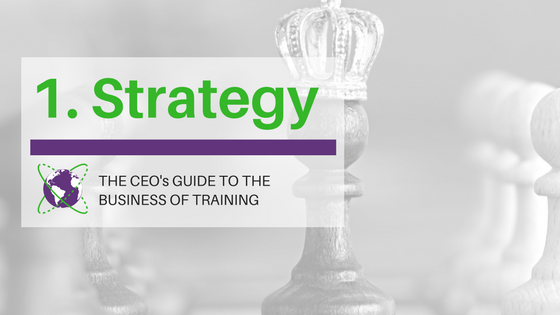The CEO’s Guide to the Business of Training, Part 1: Strategy asks how well you’ve considered the alignment between your strategic direction, and the skills of your people. It could be that they’re doing the same things they’ve always done, even though your goalposts have moved. If so, it will be hard work to hit your targets.
When you consider this, ask yourself how easily you are moving towards your strategic outcomes. Are your people doing what they need to do to make it happen? Or is there a lot of management going on to ensure it?
More to the point, when was the last time you asked yourself the question, How well are my people implementing the strategy? This question is what will unlock your next important action.
How well your people implement your strategy
Achieving strategic outcomes isn’t just about setting goals and objectives for people. It’s about change. This is particularly the case in businesses that are facing significant shifts, such as market consolidation, new technology, and new players in the market. Each of these can sometimes cause executives to take defensive action.
In all cases where you need to achieve new outcomes, setting goals is just one step. If you don’t change your people, then they are going to be doing roughly the same things they’ve always done, with the same attitudes, thought patterns, and levels of engagement.
One key that unlocks strategic success is looking beyond the numbers at how your people are trying to deliver on your stated goals.
To unlock strategic success, look beyond the numbers. How are your people trying to deliver on your stated goals? Click To TweetIf you do the same thing in the same way, can you expect a different outcome? No, you can’t.
This is one of the keys to unlocking strategic success: Looking at the underlying drivers for performance or lack of performance.
It may not just be that your people aren’t selling enough. It might be that they’re selling the way they’ve always done, and that this way of selling isn’t what you need in your changed market conditions.
The real numbers, from CEOs like you, will scare you
In late 2017, I was speaking at a business event, and asked the CEOs and business owners who were present two questions.
Those questions were:
- Do your people have the skills they need to implement your current strategy? And,
- Do your people have the skills they need to implement your business growth strategy?
The responses were astonishing.
Only 14% answered ‘yes’ to question one; and a staggering 90% answered ‘no’ to question two!
90% of CEOs surveyed said their staff didn’t have the skills needed to implement their business growth strategy. Click To Tweet
And yet, the people – who don’t have the skills – are often the first people blamed for not meeting performance expectations. Your investment in their skills may prove to be a deciding factor in whether or not your strategy succeeds.
How to make sure your training supports your strategy
Completing a gap analysis is the smartest way to make sure your training supports your strategy. Put the effort in to analyse what your training needs really are.
Before you begin, ask, What specific skills do your people need to maximise their performance for your business now and future?
Problem-solve ways of learning the answer to the question. This could be as formal as an organisation-wide skills audit, or as informal as getting data from your managers. You might consider bringing in a specialist third-party to do this study for you, so it’s completed quickly and accurately.
This first step is critical. You must know your training needs, and the gaps that you need to fill, to create training programs that result in truly impactful shift.
If you have specific business growth strategies, then you must not only prepare your team with the skills it needs to do its best work, but also enable it to deliver on your strategic outcomes consistently.
Schedule strategic planning days to occur after your skills audit
Scheduling your critical strategic planning days for when you have results to analyse allows you to include your training plans in your thinking.
The truth is, if you spend days in planning and come out with loads of ideas, new goals and numbers, but no plans for enabling your people to create that change, then I’m sorry to say you may have wasted your time.
The reason you train is to create change.
You may remember our last article about transformation, in which we talked about how change happens because the people change. Change is the entire reason why you train people. You want them to think in new ways, to have access to different methods, to relate to each other, to your clients, and to your business in new ways.
Business change - that is, getting different results - is the real reason why you train people. Click To TweetIt takes time for people to develop and embed new habits, and to become comfortable with change. But without making the effort, achieving your business growth will be a lot harder. A great example is an organisation that expected its consultants to up-sell every client over the year, but didn’t teach them how to do so (and when, and why). Once they were trained in a way that aligned the practise to the business, sales increased dramatically.
If this organisation had hit its target without training, it would have been a lucky break, rather than an intentional shift. The problem with a lucky break is that it’s really hard to repeat it.
You can expect a 15% shift when your people are aligned with your strategy
When your people have the skills they need in order to deliver on your strategies in ways that align with your vision and your brand, the difference it makes to your business is typically about 15%.
We have seen this 15% shift over and over again, in all companies that we’ve helped to align skill sets to business outcomes.
In summary: To achieve your strategic outcomes, make sure your people have the skills to do it.
Before you, as the CEO, create a new training program, make sure you have the answers to the following questions:
- How will this training have an impact on short- and long-term results?
- What is our current business performance?
- What needs to change if we are to achieve our long-term performance goals?
- What is the return on my investment?
New skills, or reinforced skills, always have to add to the bottom line. Investing in training is hard when the impact is unknown. Advocating for the budget to train people is hard when you don’t know what the return will be like. This unknown impact can stop training plans in their tracks.
Successful businesses know their numbers! Planning to train is great, but make sure you know how to measure the impact over time.
Next in the CEO’s Guide to the Business of Training: ROI
Join us for our next article in The Business of Training, in which we will teach you how to address your ‘unknown training impact’.
Subscribe now so you get the next article sent directly to your inbox.




Leave A Comment